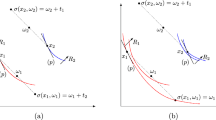Abstract
This paper has three purposes. First, we refine the characterization of the Walras rule proposed by Nagahisa (JET 1991) over a more natural and simple domain than the one he employed. We show that the Walras rule is the only social choice rule defined over the domain and satisfying Individual Rationality, Pareto Efficiency, and Local Independence. Second, assuming endowments to be collectively owned, we show that the Walras rule operated from equal division is the only social choice rule satisfying No Envy, Pareto Efficiency, and Local Independence. Third, we show that for every social choice rule satisfying Individual Rationality and Pareto Efficiency, Local Independence is equivalent to a condition of Nash implementation with a game form satisfying convexity.
Similar content being viewed by others
References
Arrow JK (1963) Social choice and individual values. John Wiley, New York Second Edition
Arrow JK, Hahn E (1971) General competitive analysis. North-Holland, Amsterdam
Barton AP, Böhm V (1982) Consumer theory. In: Arrow JK, Intrillgator MD (eds) Handk Math Econ, Vol II, Chap 9, pp 381–429
Debreu G, Scarf H (1963) A limit theorem on the core of an economy. Int Econ Rev 4: 235–246
Dutta B, Sen A (1991) A necessary and sufficient condition for two-person Nash implementation. Rev of Econ Studies 58: 121–128
Dutta B, Sen A, Vohra R (1993) Nash implementation through elementary mechanisms in economic environments. Mimeo
Foley DK (1967) Resource allocation and the public sector. Yale Economic Essays 7
Gevers L (1986) Walrasian social choice: some simple axiomatic approaches. In: Heller et al. (eds) Social choice and public decision making: essays in honor of Arrow JK, Vol 1. Cambridge Univ. Press, Cambridge
Hurwicz L (1979) On allocations attainable through Nash equilibria. J Econ Theory 21: 140–166
Hurwicz L (1979) Outcome functions yielding Walrasian and Lindahlian allocations at Nash equilibrium points. Rev Econ Stud 46: 217–225
Hurwicz L Maskin E, Postlewaite A (1980) Feasible implementation of social choice correspondence by Nash equilibria. Mimeo
Inada K (1964) On the economic welfare function. Econometrica 32: 315–338
Maniquet F (1993) Informational efficiency, horizontal equity and the equal income Walrasian rule. Mimeo
Maskin E (1977) Nash equilibrium and welfare optimality. Preliminary Version Mimeo. MIT, Cambridge
McKelvey RD (1989) Game forms for Nash implementation of social choice correspondences. Soc Choice Welfare 6: 139–156
Moore J, Repullo R (1990) Nash implementation: a full characterization. Econometrica 59: 509–519
Moulin H (1990) Uniform externalities: two axioms for fair allocation. J Pub Econ 43: 305–326
Nagahisa R (1991) A local independence condition for characterization of Walrasian allocations rule. J Econ Theory 54: 106–123
Nagahisa R (1992) Walrasian social choice in a large economy. Math Soc Scie 24: 73–78
Nagahisa R (1994) A necessary and sufficient condition for Walrasian social choice. J Econ Theory 62: 186–208
Nash J (1950) The bargaining problem. Econometrica 18: 155–162
Repullo R (1987) A simple proof of Maskin's theorem of Nash implementation. Soc Choice Welfare 4: 39–41
Saijo T (1988) Strategy space reduction in Maskin's theorem: sufficient conditions for Nash implementation. Econometrica 54: 693–700
Saijo T, Tatamitani K, Yamato T (1993) Toward natural implementation. Mimeo
Schmeidler D (1980) Walrasian analysis via strategic outcome functions. Econometrica 48: 1585–1594
Schmeidler D (1982) A condition guaranteeing that Nash allocation is Walrasian. J Econ Theory 28: 376–378
Schmeidler D, Vind K (1972) Fair net trades. Econometrica 40: 637–642
Shimomura K-I (1993) Super monotonicity and the Walras allocation rule. Mimeo
Thomson W (1979) On allocations attainable through Nash equilibria, a comment. In: Laffont JJ (ed) Aggregation and Revelation of Preferences. Northholland
Thomson W (1988) A study of choice correspondences in economies with a variable number of agents. J Econ Theory 46: 247–259
Thomson W (1985) Manipulation and implementation in economics. University of Rochester Lecture Notes
Williams S (1986) Realization and Nash implementation: two aspects of mechanism design. Econometrica 54: 139–152
Varian HR (1984) Microeconomic analysis (2nd ed) W.W. Norton & Company
Author information
Authors and Affiliations
Additional information
This article is a revised version of Toyama University Working Paper No. 141. We are grateful to Professors William Thomson, Shinsuke Nakamura, Tomoichi Shinotsuka and two anonymous referees for their detailed comments. Nagahisa is grateful for hospitality of the economics department of the University of Rochester.
Rights and permissions
About this article
Cite this article
Nagahisa, R.I., Suh, S.C. A characterization of the Walras rule. Soc Choice Welfare 12, 335–352 (1995). https://doi.org/10.1007/BF00186278
Received:
Accepted:
Issue Date:
DOI: https://doi.org/10.1007/BF00186278




